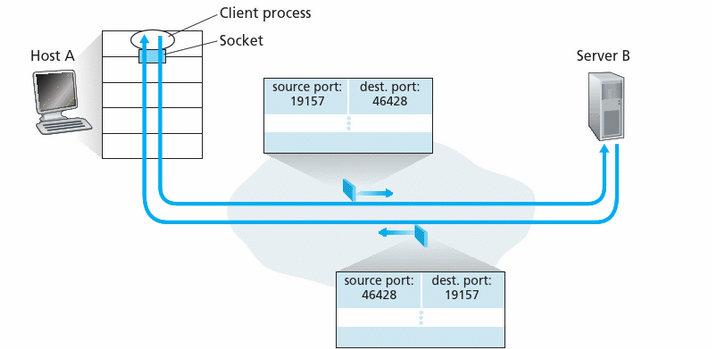Anne Reinarz Durham University
Re-cap: Socket programming
Re-cap: Socket programming
-
Goal: learn how to build client/server applications that communicate using sockets
-
Socket: door between application process and end-end-transport protocol
Re-cap: Socket programming
Two socket types for two transport services:
- UDP: unreliable datagram
- TCP: reliable, byte stream-oriented
Re-cap: UDP
- UDP: no “connection” between client & server
- No handshaking before sending data
- Sender explicitly attaches IP destination address and port # to each packet
- Receiver extracts sender IP address and port# from received packet
- UDP: transmitted data may be lost or received out-of-order
- Application viewpoint:
- UDP provides unreliable transfer of groups of bytes (“datagrams”) between client and server
Example app: UDP client
Application Example:
- Client reads a line of characters (data) from its keyboard and sends data to server
- Server receives the data and converts characters to uppercase
- Server sends modified data to client
- Client receives modified data and displays line on the screen
Example app: UDP client
import socket
def start_client():
serverName = ""
serverPort = 8800
clientSocket = socket.socket(socket.AF_INET, socket.SOCK_DGRAM)
message = input("Input lowercase sentence: ")
clientSocket.sendto(message.encode(), (serverName, serverPort))
modifiedMessage, serverAddress = clientSocket.recvfrom(1024)
print(modifiedMessage.decode())
clientSocket.close()
if __name__ == "__main__":
start_client()
Example app: UDP server
import socket
def start_server():
serverPort = 8800
serverSocket = socket.socket(socket.AF_INET, socket.SOCK_DGRAM)
serverSocket.bind(("", serverPort))
print("The server is ready to receive")
while True:
message, clientAddress = serverSocket.recvfrom(1024)
modifiedMessage = message.decode().upper()
serverSocket.sendto(modifiedMessage.encode(), clientAddress)
if __name__=="__main__":
start_server()
Re-cap: TCP
Application viewpoint:
- TCP provides reliable, in-order byte-stream transfer (“pipe”) between client and serve
Re-cap: TCP
- Server process must first be running and must have created socket that accepts client’s connection
- Client contacts server by:
- Creating TCP socket, specifying IP address, port number of server process
- When client creates socket: client TCP establishes connection to server TCP
- When contacted by client, server TCP creates new socket for server process to communicate with that particular client
- Allows server to talk with multiple clients
- Source port numbers used to distinguish clients
Outline
- Transport-layer services
- Multiplexing and demultiplexing
- Connectionless transport: UDP
- Principles of reliable data transfer
Re-cap: Layer Model
### Application: supporting network applications
- FTP, SMTP, HTTP
### Transport: process-process data transfer
- TCP, UDP
### Network: routing of datagrams
- IP, routing protocols
### Link: data transfer between neighboring network elements
- Ethernet, 802.11 (WiFi), PPP
### Physical: bits “on the wire”
Transport services and protocols
- Provide logical communication between app processes running on different hosts
- Transport protocols run in end systems
- Send side: breaks app messages into segments, passes to network layer
- Recieve side: reassembles segments into messages, passes to app layer
- More than one transport protocol available to apps
- Internet: TCP and UDP
Transport services and protocols
 </img>
</img>
Transport vs. network layer
Network layer:
- Logical communication between hosts
Transport layer:
- Logical communication between processes
- Relies on & enhances network layer services
Internet transport-layer protocols
TCP (Transmission Control Protocol)
- Reliable, in-order delivery
- Congestion control, flow control, ack., timer
</br>UDP (User Datagram Protocol)
- Unreliable, unordered delivery
- No-frills extension of IP
</br>
TCP & UDP extend IP delivery service between hosts to deliver service between processes -> transport layer multiplexing and demultiplexing
Multiplexing/demultiplexing
Multiplexing/demultiplexing
Multiplexing at sender
- Handle data from multiple sockets, add transport header (later used for demultiplexing)
</br>
Demultiplexing at receiver
- Use header info to deliver received segments to correct socket
Multiplexing/demultiplexing
 </img>
</img>
Multiplexing/demultiplexing
Example
- Host C initiates 2 HTTP</br> sessions to B
- Host A initiates 1 HTTP</br> session to B
- Server B demultiplexes
correctly as the two</br> identical port numbers</br> come from different IP addresses </img>
</img>
correctly as the two</br> identical port numbers</br> come from different IP addresses
 </img>
</img>
TCP/UDP Segment format
- Host receives IP datagrams
- Each datagram has source IP address, destination IP address
- Each datagram carries one transport-layer segment
- Each segment has source, destination port number
TCP/UDP Segment format
- Host uses IP addresses</br>
& port numbers to direct </br>
segment to appropriate</br> socket
- Each socket has a unique identifier
 </img>
</img>
 </img>
</img>
Connectionless multiplexing/demultiplexing
- All sockets have host-local port #
- Assigned automatically, or via
bind() serverSocket.bind((ip,port))
</br>
Recall: when creating datagram to send into UDP socket, must specify
destination IP address and port #
Connectionless multiplexing/demultiplexing
- When host receives UDP segment:
- Checks destination port # in segment
- Directs UDP segment to socket with that port #
</br>
If two UDP segments have different source IP addresses and/or source port numbers but same dest. IP & port #, they will be directed to same process via same socket at destination
Connectionless multiplexing/demultiplexing
-  </img>
</img>
serverSocket.bind((’’, 6428))
- clientSocket = socket(...)</br> #assigned port 9157
- clientSocket = socket(...)</br> #assigned port 5775
 </img>
</img>
Reliable data transfer
Reliable data transfer
- Important in application, transport, link layers
- Top-10 list of important networking topics
- Characteristics of unreliable channel will determine the complexity of a reliable data transfer protocol (rdt)
Reliable data transfer
 </img>
</img>
Reliable data transfer
- A reliable protocol (TCP) may be implemented on top of an unreliable end-to-end network layer (IP)
- Reliable transfer over UDP:
- Add reliability at application layer
- Application-specific error recovery
Summary
- Principles behind transport layer services
- Multiplexing, demultiplexing
- Connectionless transport
- UDP: datagram protocol
- UDP segment format and checksum
- Connection-oriented transport
- Basic structure of reliable data transfer